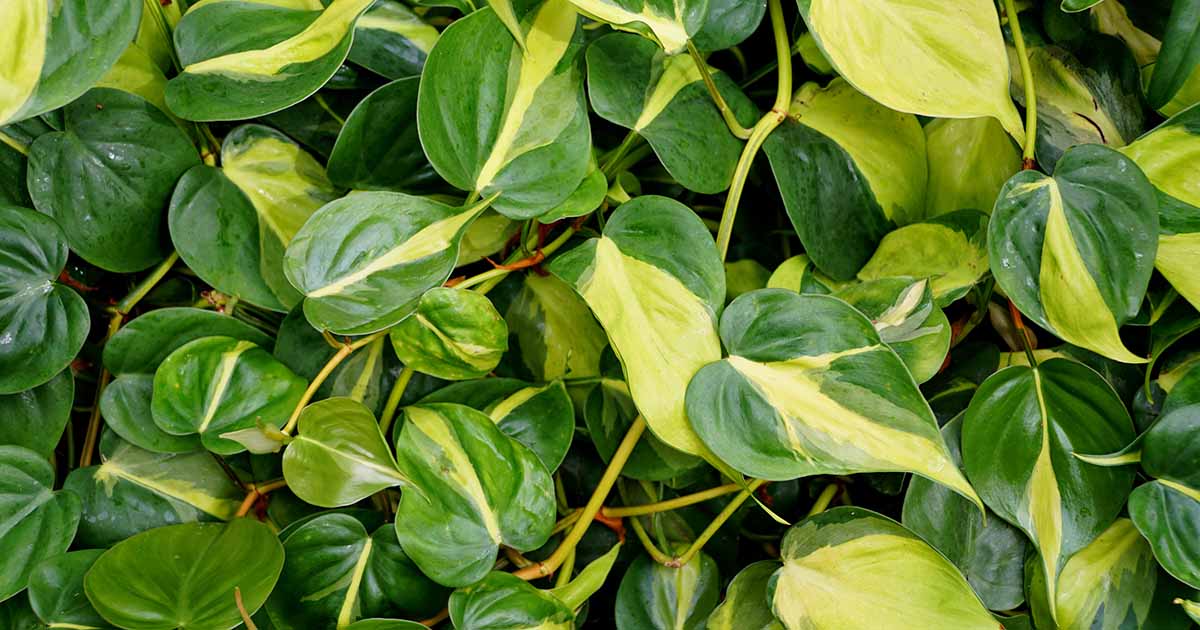
Philodendron hederaceum ‘Brasil’
The standard heartleaf philodendron is charming, but add some variegated lime and lemon coloring to the green foliage, and you’ve got an extra special houseplant.
Since ‘Brasil’ hit the market a few decades ago, it has become a must-have philodendron, and it’s not hard to see why. This cultivar is tough, easygoing, and undeniably good-looking.
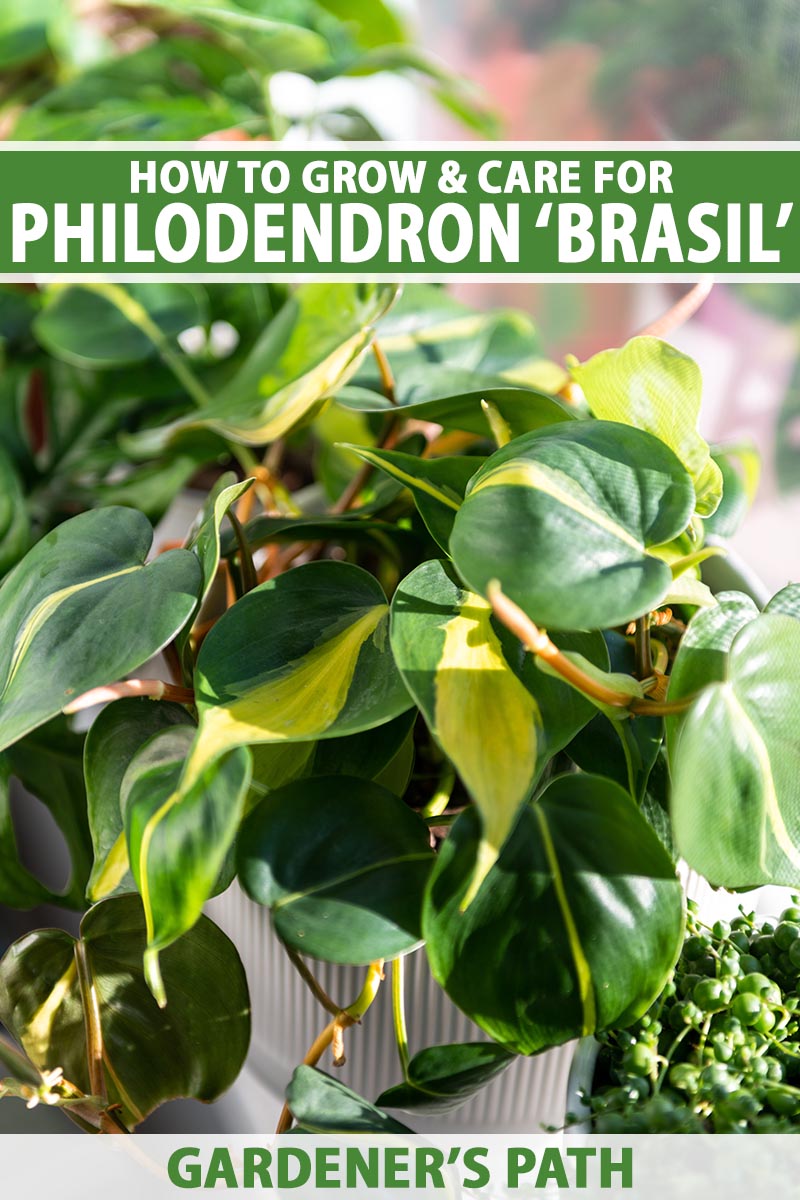
We link to vendors to help you find relevant products. If you buy from one of our links, we may earn a commission.
If you’re ready to learn where P. hederaceum ‘Brasil’ came from and how to cultivate your own, this guide can help.
Here’s what’s in the coming attractions:
Let’s start by talking about where this beloved cultivar came from:
Cultivation and History
Philodendron hederaceum ‘Brasil’ is a heartleaf philodendron cultivar that stands out from the species plant with its lemon, lime, and dark green variegated foliage.
P. hederaceum used to be classified as P. scandens, so you might see it sold under that name.
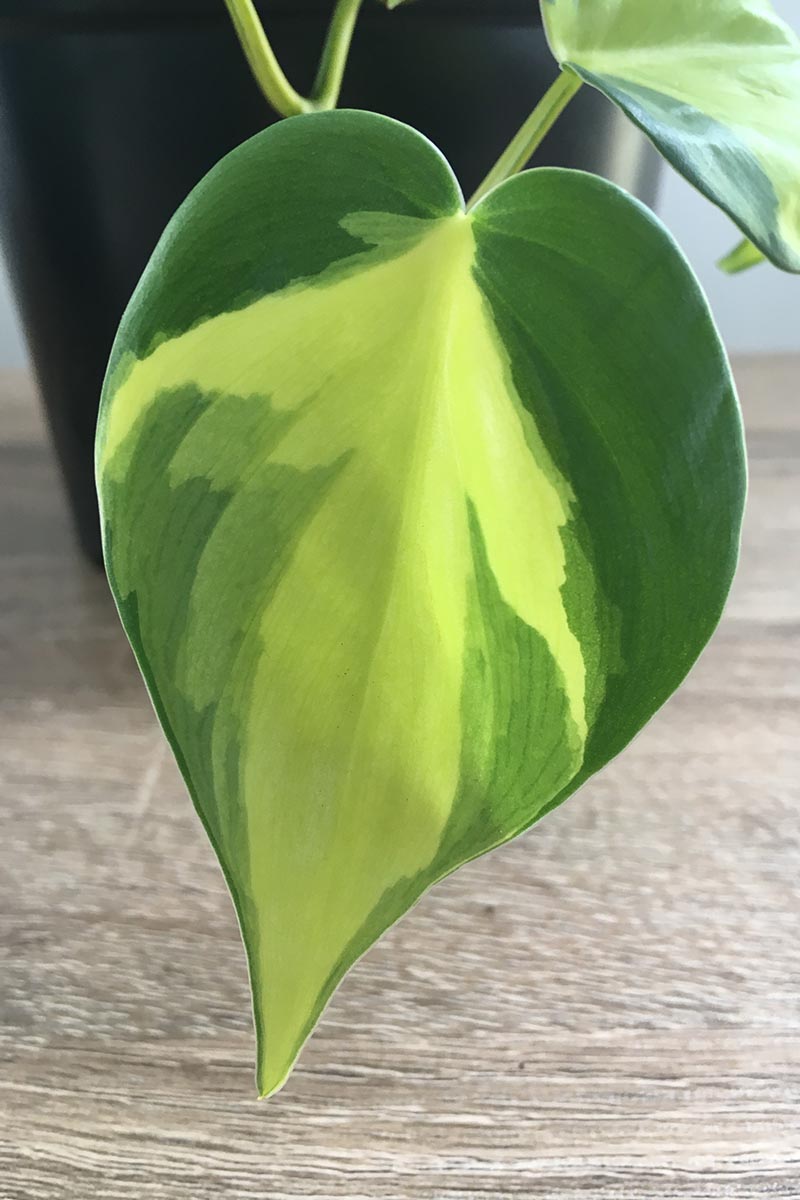
The young stems and petioles emerge as a beautiful reddish-pink and age to reddish-orange before turning green with light green and sometimes yellow variegation when mature.
It has a cascading, trailing growth habit and attaches itself to supports via a twining growth habit and aerial roots.
The variegation is unstable, which means that no two leaves will look alike, and sometimes leaves will be entirely yellow, light green, or green.

In the wild in South America where the species grows indigenously, the plant is a secondary hemiepiphyte.
It starts life in the soil and later attaches to a tree or shrub to access light, water, and nutrients. It’s not a parasite; it just uses the other plant as a host structure without hurting it.
It’s all in the name. Philo is Greek for love and dendron means tree. This philodendron is a tree lover!
‘Brasil’ was patented in 2000 by Kerry’s Bromeliad Nursery in Florida after a mutation was discovered by Ruben Ernesto Acosta in a greenhouse in Holambra, Brazil, in 1991.
The mutation was further bred and stabilized before the nursery released it to the market.
It quickly caught the eye of houseplant lovers and has become extremely popular. And good news! The patent expired in 2020, so feel free to propagate ‘Brasil’ at home without fear of violating the patent.
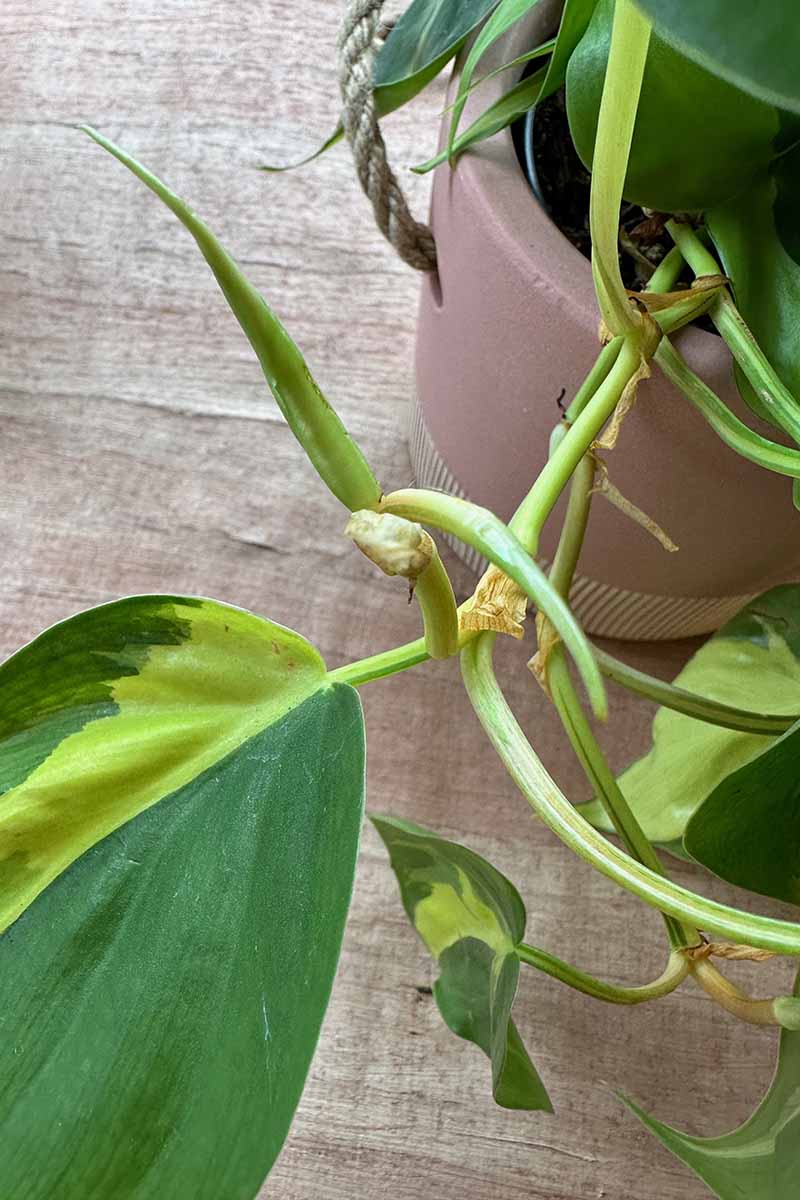
Poor ‘Brasil’ suffers from a case of mistaken identity. It’s often confused with variegated pothos (Epipremnum aureum) cultivars.
You can tell the difference between philodendron ‘Brasil’ and variegated pothos by looking at new leaves. On a philodendron, the leaves emerge from waxy sheaths.
Foliage on a pothos emerges from inside another leaf. Even if your plant doesn’t have any young leaves, look for the presence of a sheath at the base of the petioles.
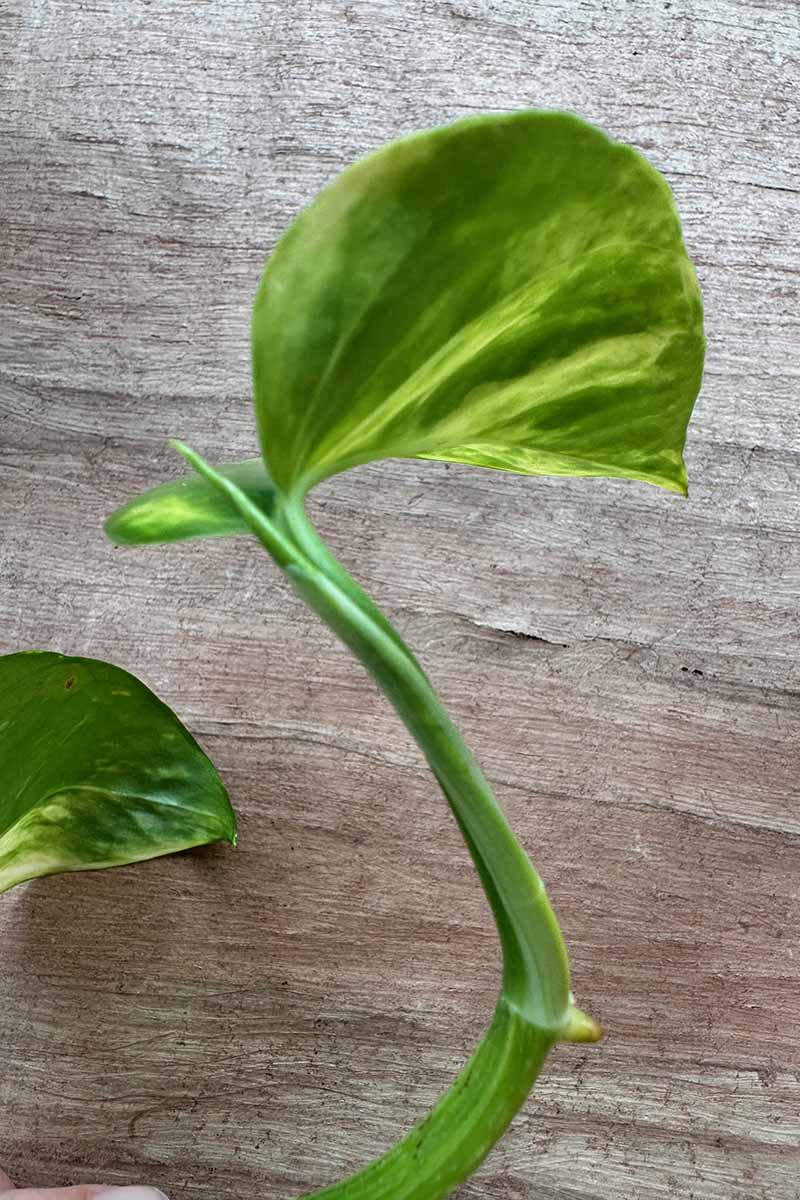
The leaves also have longer apices – the pointy tip – than pothos and the species.
When mature, ‘Brasil’ can trail a dozen feet or more, though the vines typically grow about two feet long in an indoor environment.
It’s closely related to Philodendron micans (syn. P. hederaceum var. hederaceum), though it lacks the velvety texture and bronze coloring of the foliage.
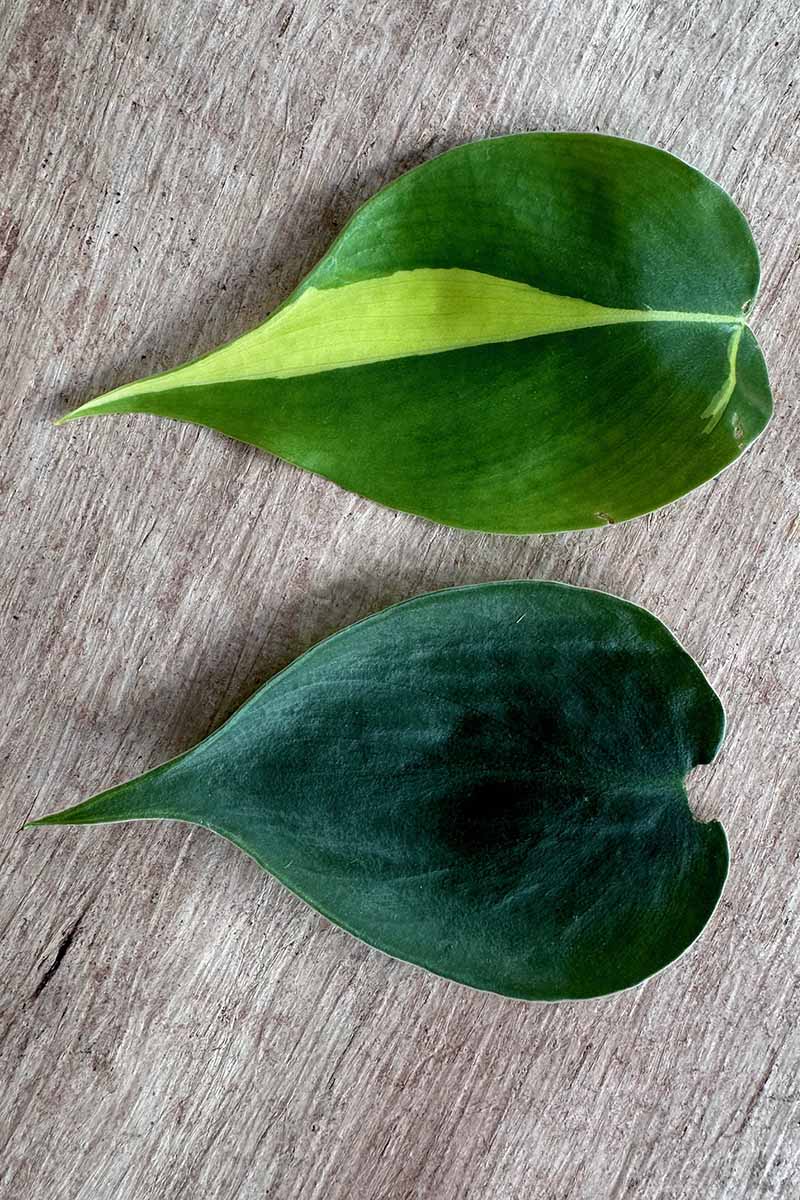
If you’d like to learn more about philodendrons and how to care for them, read our comprehensive guide.
Philodendron ‘Brasil’ Propagation
Propagating ‘Brasil’ is pretty straightforward. It’s especially easy to do via cuttings. As the plant becomes larger, division is a good option, as well. Let’s start with that:
From Division
A big, bushy philodendron is ripe for division. This process is best done in the spring or summer, but as with cuttings, it can be done any time of year.
Remove the plant from its pot and brush away as much of the soil as you can. You really want to be able to see the roots clearly.
Try to tease a section of roots and stems apart as carefully as you can. If you need to, take a clean pair of pruners or clippers and trim apart any stubborn roots.
Repot the original section back in its container and fill in around the roots with fresh potting soil.
Pot the new section in a container with fresh potting soil.
From Cuttings
Philodendrons propagate from cuttings readily. You can grow them in either water or a potting medium.
Look for a healthy stem and cut off about four inches from the tip.
There should be at least two leaf nodes and bonus points if you also include an aerial root node. Nodes look like little brown bumps on the stem.
Make your cut just underneath a leaf or aerial root node.

Remove all but the top leaf and put the cut end in water or potting medium. If you use water, replace it every few days to deter pathogens.
If you use a potting medium, keep it moist but not wet. You want it to be the texture of a well-wrung-out sponge.
Keep the cuttings in a spot with bright, indirect light and allow them to develop roots. This usually takes a few weeks.
If you don’t see new growth above the soil after a few weeks, gently dig under the cutting with your fingers and lift the cutting out to see if it has rooted.
If you see lots of roots, you can go ahead and transplant your new plant. If not, replace it and wait a bit longer. As long as the cutting doesn’t wilt or die, you can safely keep waiting.
The process takes longer in the winter than the spring or summer, but it will work any time of year.
Potted Transplants
Most of us end up buying potted philodendron ‘Brasil’ plants at a nursery or planting a cutting that we or someone we know has grown.
To transplant a potted specimen into a new container, gently remove it from its pot and loosen up the roots a bit. Look for any dead or broken roots and cut them off.
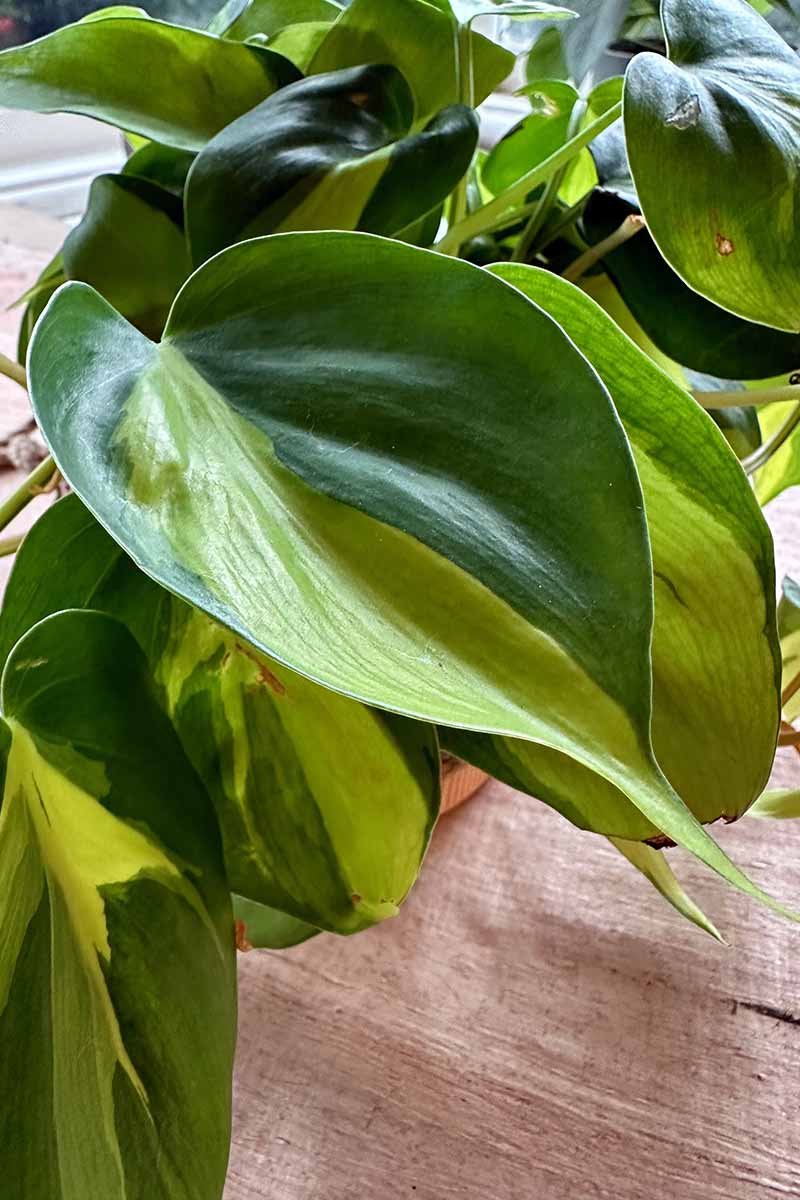
Set the ‘Brasil’ plant in a new container one size larger than the existing container.
Add a thin layer of potting soil in the bottom of the pot before setting the new plant into the container, and then fill in around it with fresh soil.
You want the plant to be sitting at the same height it was in its original container.
How to Grow Philodendron ‘Brasil’
First, let’s talk about the foundation of any houseplant: the soil. Your ‘Brasil’ will be pretty forgiving, but it’s always best to give it the optimal conditions, if you can.
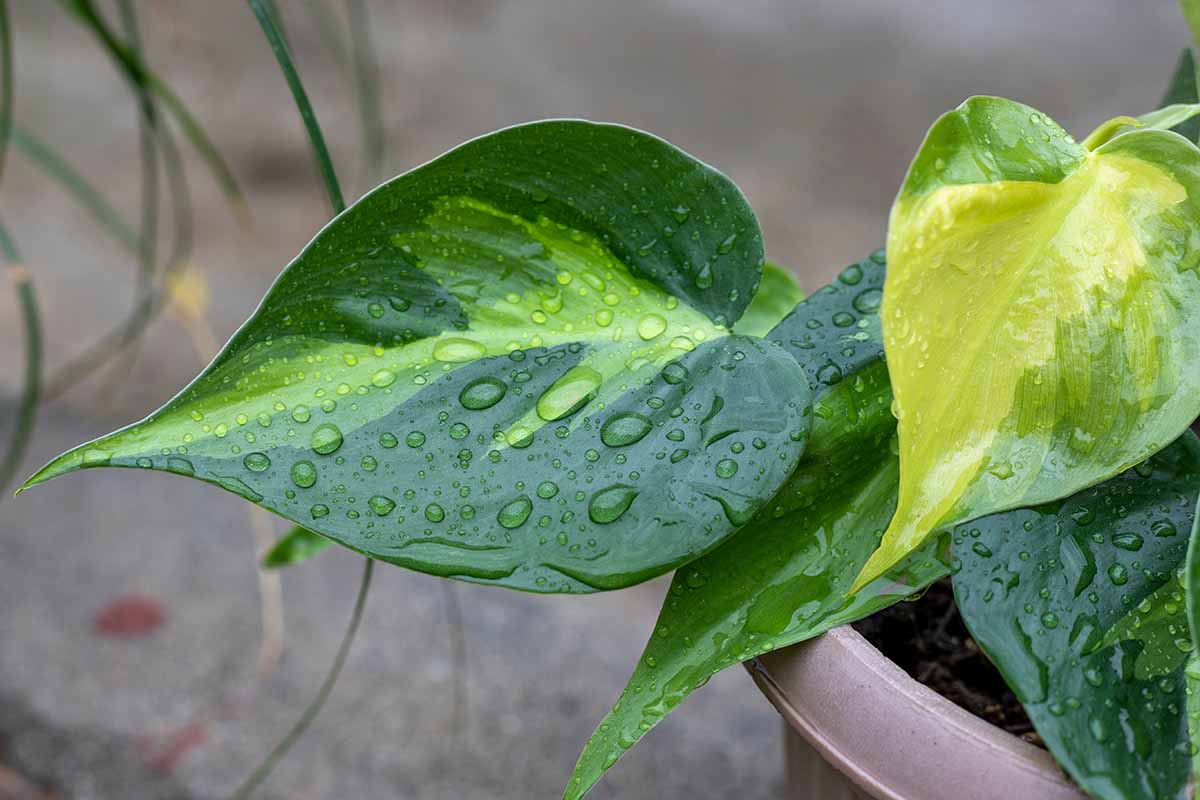
Slightly acidic to neutral soil that is water-retentive but airy and well-draining is ideal for philodendrons. You can find a lot of commercial potting mixes with this combination.
My personal favorite is Fox Farm Ocean Forest potting mix.
It’s what I grow most of my houseplants in because it has a mix of earthworm castings, bat guano, fish meal, humus, and peat moss that my plants seem to love.
FoxFarm Ocean Forest Potting Mix
You can find a 12-quart bag via Amazon if you’d like to try it.
Then there’s the soil moisture. Try to keep the soil as moist as a well-wrung-out sponge but not wetter.
The soil’s surface can be allowed to dry out, and your plant will be fine, but don’t allow the entire substrate to become dry.
Don’t worry, a philodendron will signal to you that it needs more moisture by drooping. Try to water just before this happens.
Part of what makes ‘Brasil’ so special is the yellow, lime, and green variegation on the foliage. The correct light exposure is a critical element in creating and maintaining that color.
If the plant is situated in a location that is too dark, the leaves will revert to solid green or develop little variegation.
Aim for bright, indirect light all day or direct morning sun followed by bright, indirect light the rest of the day. Afternoon light is too harsh and will burn the foliage.
I know it’s confusing when gardeners talk about about bright, indirect light. What is that, exactly? It’s the kind of light you find within a foot or two of a south-facing window that is covered in a sheer curtain.
High light exposure might also cause the leaves to emerge as bright green with little or no variegation. This lack of variegation can also happen because the solid coloration is built into the plant’s genetics. When this happens, it’s called reversion.
If you don’t like the appearance, trim off the solid leaves and reduce the light exposure a little and wait a few months for new, variegated leaves to form.

Don’t expose this plant to temperatures below 59°F. They aren’t even the least bit cold tolerant (same, ‘Brasil,’ same).
I know you probably keep your house warmer than that, but if you put the plant next to a single-pane window or a door and you live in a region with frigid winters, it could damage your plant.
Feel free to keep your philodendron outdoors when it’s warm enough, but only those in Zones 11 and 12 can leave them outside year-round.
Being secondary hemiepiphytes, philodendrons prefer to have something to climb up, but you can allow them to trail out of a container if you prefer.
If you go the climbing route, they can wind up the rope of a hanging planter, or you can guide them up a moss pole.
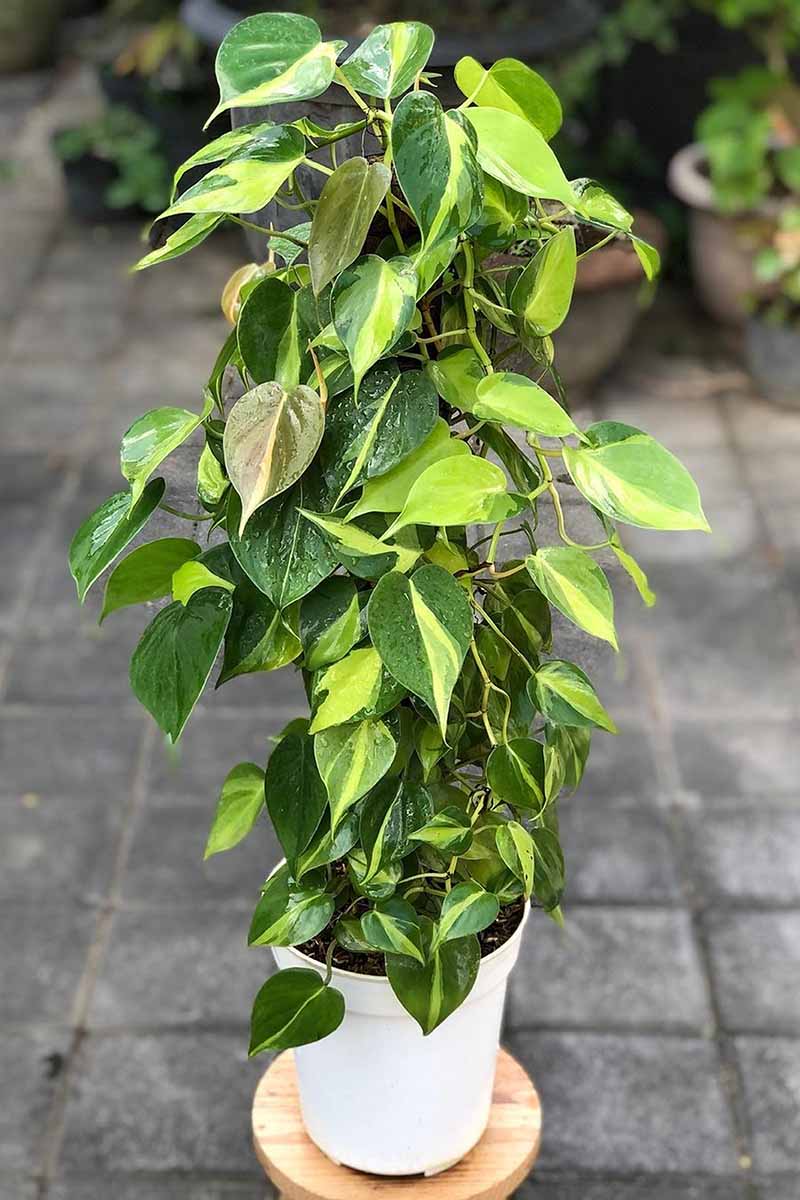
Speaking of containers, the size is important. Most aroids like their roots to be a little snug and ‘Brasil’ is no different.
If the roots don’t take up at least half the container, it’s too big, and you increase the risk of overwatering.
Your container should also have drainage holes. I love a pretty decorative pot as much as the next person, but those should be used as your outer cachepot unless they have drainage.
Keep the plant in a grower’s pot with drainage holes and place that inside the decorative pot.
When you water, be sure to empty out the cachepot or saucer after about 30 minutes.
Growing Tips
- Provide bright, indirect light. Too much light will reduce variegation.
- Keep the soil moist but not soaking wet.
- Protect the plant from temperatures below 59°F.
Pruning and Maintenance
If you like the look of your philodendron, feel free not to prune it. ‘Brasil’ doesn’t need regular haircuts to stay healthy.
But if you see any dead, diseased, or deformed leaves or stems, get rid of them. You can also trim back to just in front of a leaf node if you want to encourage bushiness.
‘Brasil’ plants that are growing in low light tend to be leggy. Some judicious pruning can undo some of the leggy growth.
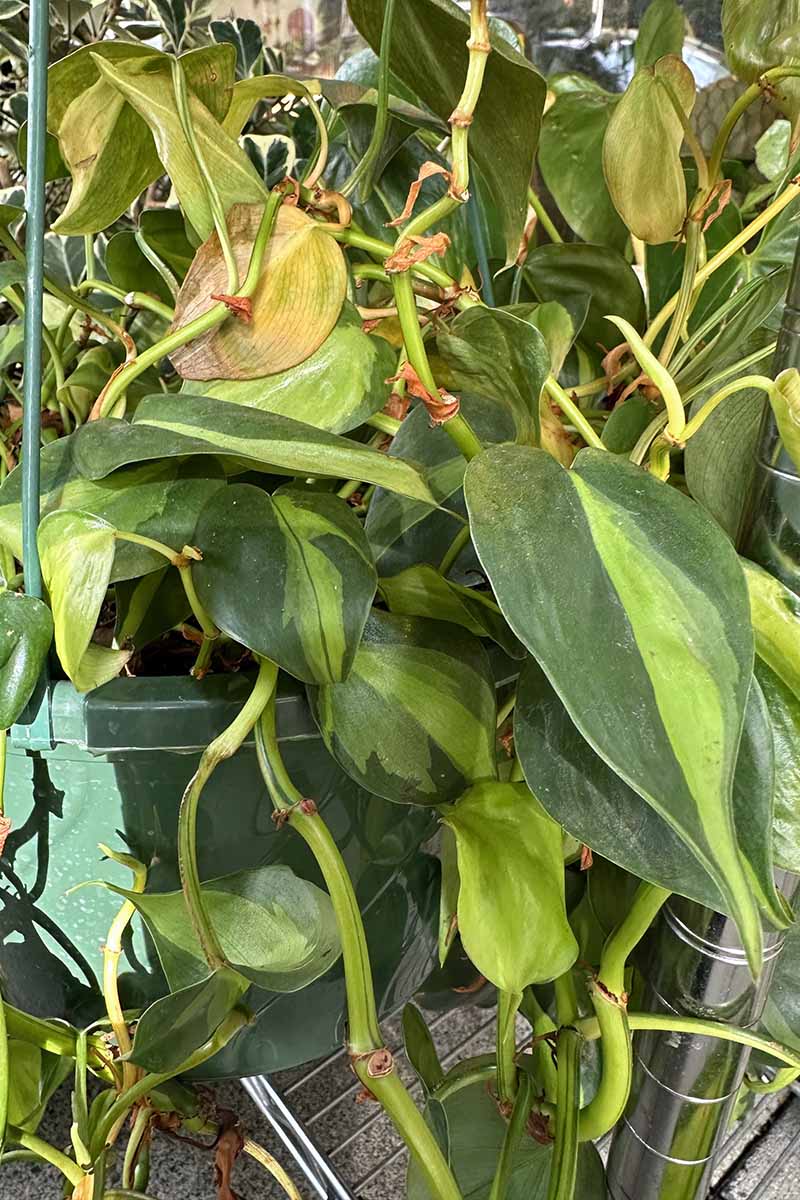
For more information, please read our guide to pruning philodendrons.
You should also repot your philodendron every so often as it grows. Once the roots are coming out of the drainage holes or are circling the perimeter of the pot, it’s time to upgrade the container.
If you aren’t sure, go ahead and stick your finger into the soil as deep as you can. If you can’t get in there very deep because you hit resistance from the roots, that’s a sure sign it’s time.
To repot, remove the plant from the existing pot and brush away the soil from the root ball.
Place the plant in a new container that is one size larger (or more, if the plant is extremely rootbound) and fill in around the roots with fresh, new soil.
Where to Buy Philodendron ‘Brasil’
While it isn’t the most popular philodendron out there, it’s not far off. ‘Brasil’ is pretty common, and you can find it at most houseplant retailers.
I popped into three local houseplant sellers by my house, and all of them had one.
If you don’t want to shop around, you can easily find it online, too. American Plant Exchange has a live plant in a six-inch pot at Amazon.
Or Home Depot carries it in a smaller four-inch pot.
Managing Pests and Disease
This is a pretty robust cultivar, and you probably won’t run into many issues unless your ‘Brasil’ is stressed.
Keep it fed, watered, and in the right light, and any problems will be rare. Pests are the most common issue, so let’s talk about those first.
There are a few common houseplant pests that you’ll see over and over on many species. These include aphids, mealybugs, and scale.
All of these will attack ‘Brasil,’ especially one that is stressed.
Disease
When it comes to diseases, bacterial leaf spot isn’t common, but it does show up from time to time.
It’s caused by the bacteria Xanthomonas campestris pv. dieffenbachiae and results in water-soaked spots with brown or yellow haloes. As the spots age and grow, the centers turn tan.
There isn’t a cure, so snip off any symptomatic leaves and don’t share tools, soil, or containers between plants without cleaning them thoroughly first.
Best Uses for Philodendron ‘Brasil’
As a hanging plant, ‘Brasil’ is hard to beat. It’s beautiful when trained up walls or poles, or allowed to trail down shelves and bookcases.
Quick Reference Growing Guide
| Plant Type: | Herbaceous aroid, secondary hemiepiphyte | Foliage Color: | Green, lime, lemon, variegated |
| Native to: | Cultivated variety | Tolerance: | Low light, low soil fertility |
| Hardiness (USDA Zone): | 11-12 | Soil Type: | Humus-rich, airy |
| Exposure: | Bright, indirect light | Soil pH: | 6.0-7.5 |
| Time to Maturity: | 8 years | Soil Drainage: | Well-draining |
| Length: | 15 feet | Uses: | Ornamental houseplant, specimen, wall covering, borders |
| Spread: | 5 feet | Order: | Alismatales |
| Water Needs: | Moderate | Family: | Araceae |
| Maintenance: | Low to moderate | Genus: | Philodendron |
| Growth Rate: | Fast | Species: | Hederaceum |
| Common Pests and Diseases: | Aphids, mealybugs, scale, spider mites; bacterial leaf spot, root rot | Cultivar: | ‘Brasil’ |
Bring Beautiful ‘Brasil’ to Your Home
I have found that some of the more visually appealing houseplants out there tend to be some of the fussier ones.
I think Alocasia species are beautiful, but they aren’t easy to raise. Philodendron ‘Brasil’ bucks the trend. This tropical beauty is as easy to care for as a cactus.
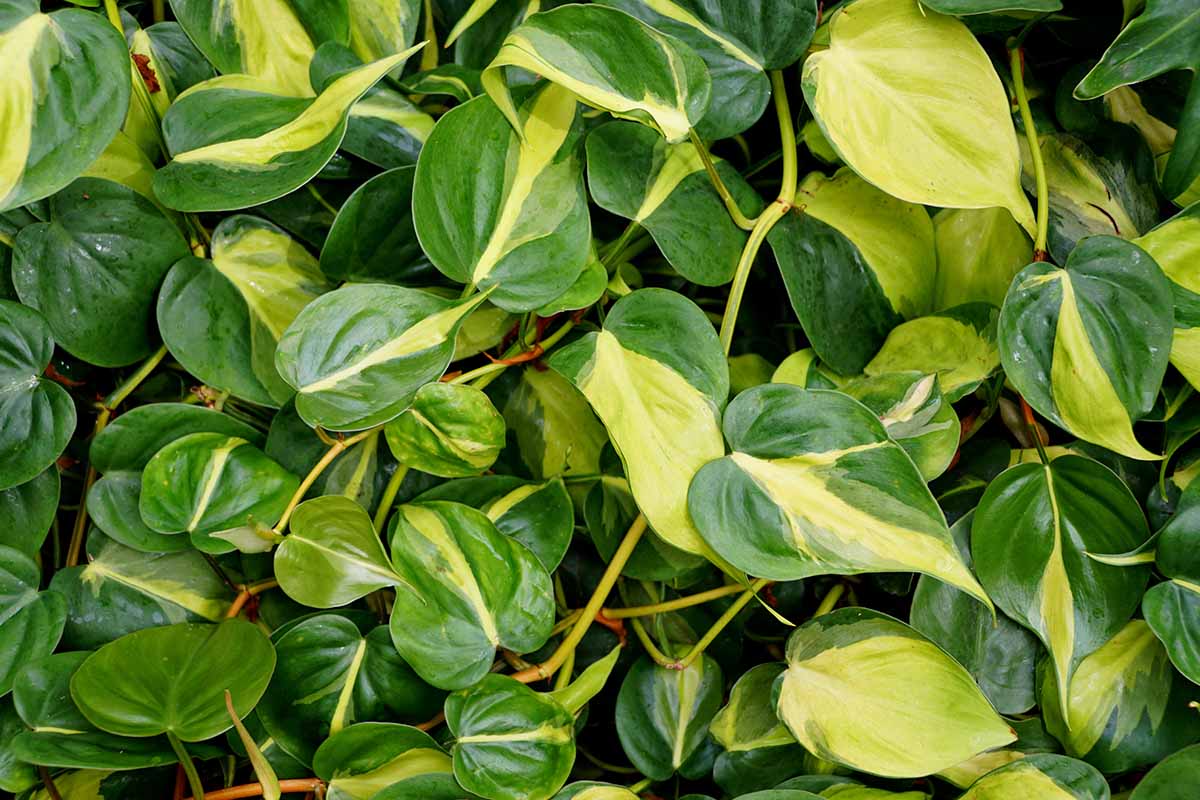
Is this your first philodendron? Or maybe just your first ‘Brasil?’ Let us know about your experiences with this fantastic plant in the comments section below.
And if you still want to know more about philodendrons in general, we recommend these guides next:








